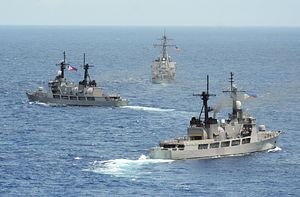Last week, during a press conference with reporters, Philippine Defense Secretary Delfin Lorenzana suggested that the Philippines should look to significantly boost its military budget after decades of underfunding.
“I’ve been talking to some of the congressmen and we should also increase our budget. We have been underfunded for the past 50 years,” Lorenzana said.
When asked if he had a specific figure in mind, he suggested that he would be happy with a rather dramatic increase from around 1 percent of GDP (what the Philippines spend now on defense) to around 2.4 to 2.5 percent of GDP.
Lorenzana’s comments reflect a long-held recognition of the need for the Philippines to increase its defense budget. As I’ve noted before, despite the fact that Manila’s military modernization efforts during the past few years have been vigorous relative to anemic periods in the past, the fact is that the Philippines is one of Asia’s weakest militaries and is building from a very low base (See: “The Truth About Philippine Military Modernization and the China Threat”).
Yet the Philippines faces a range of internal and external challenges – including insurgencies, natural disasters, unresolved territorial and sovereignty issues with neighboring states, and a significant lag when it comes to keeping up with the Joneses in Asia more generally. As Lorenzana correctly noted, the Philippines spends around 1 percent of its GDP on defense spending, which is behind the Southeast Asian average of around over 2 percent of GDP.
Indications so far are that defense budget increases will continue under Philippine President Rodrigo Duterte, even though the numbers still fall far short of the 2.4-2.5 percent of GDP target Lorenzana outlined (See: “Philippine Defense Policy Under Duterte: What’s In A Budget?”).
Under Duterte’s 3.35 trillion peso (around $70 billion) budget for 2017 signed into law on December 22 – the biggest ever of its kind – 137.2 billion pesos was allocated for defense, compared to 117.5 billion pesos for 2016. That constituted a roughly 17 percent year-on-year increase but it is still just around 1 percent of GDP. It is important to note, though, that this does not include the spending for procurement under the Armed Forces Modernization Act initiated in 2013, which will see the Philippines spend 25 billion pesos for the year.
Whether or not we see more dramatic budget increases over the next few years to get closer to Lorenzana’s target will depend on a range of factors, including the state of the Philippine economy; the balance of priorities of the Duterte government; the state of the regional security environment; and the willingness of Congress to approve budgets submitted by the administration.
For instance, Duterte’s 2017 budget indicates a focus on boosting spending on a number of key domestic areas, such as infrastructure, social services, agriculture, and internal security as the administration wages triple wars against crime, illegal drugs, and terrorism and insurgency. That more diversified, domestic-centric list of priorities will mean that although defense will not be ignored, its will have to share any budget increases with other areas as well.
Finally, as I have noted before, though attention is often devoted to defense budget totals, equally if not more important will be the distribution of the budget among the services as well as what is being bought under the separate modernization budget. On the former question, a point not missed on close observers of Philippine defense affairs was that though the Philippines needs to boost its aerial and maritime capabilities in the South China Sea, detailed 2017 budget breakdowns by the Department of Budget and Management indicate that among the three main services – the Army, Navy and Air Force – around 57.4 billion pesos went to the Army, 21 billion pesos to the Navy, and 18.9 billion pesos to the Air Force.
With respect to the latter point, the Philippines is entering the second “horizon” or phase of military modernization in 2018 (the first lasts until 2017; the second runs from 2018 to 2023; and the third runs from 2024 to 2028). As Lorenzana indicated during the press conference, that means that the Duterte government will be able to have a say on finalizing the list of items to be bought over the next few years, which have included fighter jets, helicopters, frigates, radars, and base upgrades in the past. What it chooses to do with this growing though still modest budget will tell us a lot about the defense picture for the Philippines during the rest of Duterte’s tenure. Until the Philippines reaches Lorenzana’s ambitious 2.4-2.5 percent of GDP target, it is these more modest metrics that are worth watching closely.

































